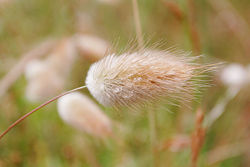Grass
| True grasses | ||||||||||
|---|---|---|---|---|---|---|---|---|---|---|
| 240px Flowering head of Meadow Foxtail (Alopecurus pratensis), with stamens exserted at anthesis | ||||||||||
| Scientific classification | ||||||||||
| ||||||||||
| Subfamilies | ||||||||||
|
There are 7 subfamilies: |
The grass family, Poaceae, is one of the largest plant families, and to us humans perhaps the most important. There are about 600 genera and perhaps 10,000 species of grasses. It is estimated grasslands comprise 20% of the vegetation cover of the earth.
What is Grass?
Grasses, like orchids and palms, are monocotyledonous, having only one cotyledon, or embryo leaf, rather than the two found in most flowering plants. Most grasses grow low to the ground, although a few, such as corn, sugar cane, and bamboo, are very tall.
Grasses generally have the following characteristics:
- Typically hollow stems (called culms), plugged at intervals (the nodes).
- Leaves, arising at nodes.
- Leaves differentiated into a lower sheath hugging the stem for a distance and a blade; a ligule (a membranous appendage or ring of hairs) lies at the junction between sheath and blade.
- Small, wind-pollinated flowers (called florets) sheathed inside two glumes (bracts), lacking petals, and grouped into spikelets, these arranged in a panicle, raceme, spike, or head.
- Fruit that is a caryopsis, the seed and fruit merged together to form a hard dry grain.
Grass leaves grow from the base of the blade. This enables them to quickly regrow after being eaten by animals, or mowed by a lawn mower. Most grasses send out creeping stems, called stolons if they grow above the ground and rhizomes if they grow below the ground, from which grow new plants. Some grass species are annual, dying at the end of each growing season and leaving seed to grow a new generation the next season, while some are perennial, living for more than one or two years.
Grass in Nature
Most grasses grow in places that are too dry for forests. Grasslands are areas dominated by grass. Prairies are wetter with taller grasses while steppes are dryer with shorter grasses. Savannas are glasslands with widely spaced trees. Large areas of grassland are found in Europe, Asia, Africa, North and South America, and Australia. Many animals depend on the leaves and grains of grasses for food; grasslands support a rich community of living things. Their roots hold the soil in place preventing erosion while their rapid growth allows them to quickly repopulate and recover an area after a fire.
Grass and Humans
External links and references
- Kew Index of World Grass Species
- Definitions of Grass structures
- Poaceae in L. Watson and M.J. Dallwitz] (1992 onwards). The families of flowering plants: descriptions, illustrations, identification, information retrieval.
- L. Watson and M. J. Dallwitz (1992 onwards). The grass genera of the world: descriptions, illustrations, identification, and information retrieval; including synonyms, morphology, anatomy, physiology, phytochemistry, cytology, classification, pathogens, world and local distribution, and references.
Credits
New World Encyclopedia writers and editors rewrote and completed the Wikipedia article in accordance with New World Encyclopedia standards. This article abides by terms of the Creative Commons CC-by-sa 3.0 License (CC-by-sa), which may be used and disseminated with proper attribution. Credit is due under the terms of this license that can reference both the New World Encyclopedia contributors and the selfless volunteer contributors of the Wikimedia Foundation. To cite this article click here for a list of acceptable citing formats.The history of earlier contributions by wikipedians is accessible to researchers here:
The history of this article since it was imported to New World Encyclopedia:
Note: Some restrictions may apply to use of individual images which are separately licensed.
